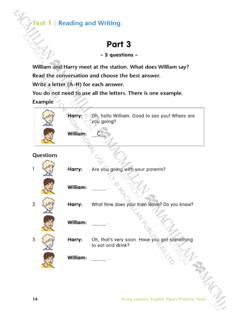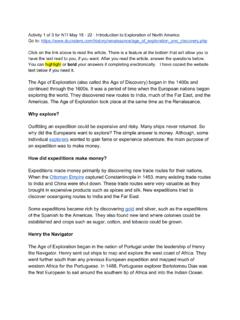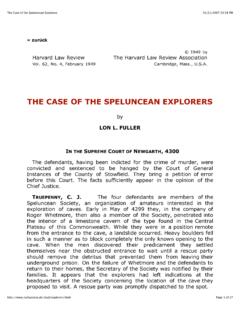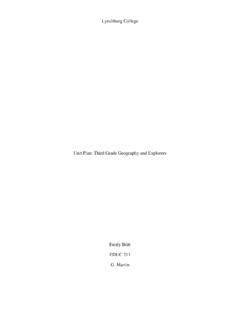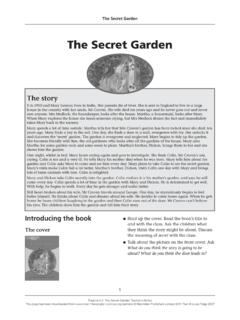Transcription of The Railway Children - Macmillan Education Everywhere
1 Explorers 6: The Railway Children Teacher s NotesThis page has been downloaded from learners Macmillan Publishers Limited 2011 Text Louis Fidge 2007 The Railway ChildrenThe storyRoberta, Peter and Phyllis live happily with their parents until one day when two men come and take their father away. Their mother looks worried and tells them their father will be away for a long time. They then move to the country to and the Children get used to their new life. Their new house is near a Railway line and so the Children explore the area and the Railway station. Unfortunately, the family can t afford to buy coal for their fire now, so Peter takes some coal from the Railway station. He is caught by the station master, who decides not to do anything about Children become fascinated with the Railway . One day an old man goes past on a train and waves to them. This becomes a regular event.
2 To earn money, their mother writes books for Children , but one day she becomes ill. The Children write a letter to the old man and ask him for food to help their sick mother. Mother writes and thanks the old Children have lots of adventures. Roberta and Peter have a ride on a train engine. On another occasion there is a landslide onto the Railway track and the Children manage to stop the oncoming train before there is an accident. Another time, the Children watch a running race and help one of the boys, who has slipped and broken his leg. Jim, the boy, stays with Roberta s family while his leg gets better. Jim s grandfather comes to see the boy and turns out to be the old gentleman!By chance, Roberta sees a newspaper article about her father which says he has been sent to jail for five years for being a spy. Mother tells her the full story and says her father is innocent.
3 Roberta writes to the old gentleman and asks for his day Roberta feels restless and is sure something exciting is going to happen. She goes to the station. To her amazement, when a train comes in her father gets off it. Her father tells her that the old gentleman persuaded the police to free him from jail. Roberta and her father return home and the family is happily reunited again!The Railway ChildrenIntroducing the bookThe coverl Hold up the cover. Read the book s title to and with the Talk about the picture. Ask the class where they think the story takes place. Elicit from the class anything they know about steam Ask What do you think the story is going to be about? (As the title suggests, the book is about Children who live near a Railway .)1 Explorers 6: The Railway Children Teacher s NotesThis page has been downloaded from learners Macmillan Publishers Limited 2011 Text Louis Fidge 2007 The Railway ChildrenTitle pagel Ask the Children to turn to the title page.
4 Explain that this story is a classic story (one that is very good and has been popular for a long time) and that it has been adapted (made simpler). Ask Who is the author? Who adapted the story?l Ask if any of the Children has ever been on a Railway journey. If they have, encourage them to recount their experiences to the Hold up your own book and point to the picture. Ask What can you see in the picture? Is it a modern train? Why is there smoke coming from the engine? (It is a steam engine.) Do you know what makes a steam engine work? (Coal is used to make a fire inside an oven in the engine. This heats water that is stored inside the body of the engine. The resulting steam provides power to turn the wheels. The rest of the steam can then be seen coming out of the chimney .) Point out that the train runs on metal Railway lines. Ask What are the three Children doing?
5 How many girls are there? What are their clothes like? When do you think the story takes place? The contents page l Ask the Children to turn to the contents page. Explain that the Contents list tells us what is in the book. Explain that the story is divided into chapters. l Ask How many chapters are there? Read the chapter titles to and with the class. Briefly explain any unfamiliar words (most will be covered in the chapter notes). Explain that Peter and Jim are boys who appear in the Point out that at the end of the book there is a poem (on page 90), some facts about trains (beginning on page 92) and some information about the author (on page 96).l Ask questions about each chapter to stimulate the Children s interest, for example: Chapter 1: Do you know what a chimney is? Chapter 5: Why do you think someone wants to stop a train? In which chapter is the word secret used?
6 In which chapter is there a surprise?l Tell the Children to do the related activity on page 1 of their Workbook. You can play the story on the audio cassette/CD at any time you 6: The Railway Children Teacher s NotesThis page has been downloaded from learners Macmillan Publishers Limited 2011 Text Louis Fidge 2007 The Railway ChildrenChapter 1 Three ChimneysPages 5 to 13 Active vocabularycountry the ou sounds like a short u in this worddisappear the prefix dis gives the word appear the opposite meaningengine the g is a soft g and sounds like j fetch other words containing tch are: catch, ketchup, kitchenfrown rhymes with crown and browngloomy the noun gloom is changed into an adjective by adding the suffix y lonely the y is pronounced ee , as in country, gloomy and ordinaryordinary there s a loud noise hidden in this word (din) Railway this is a compound word.
7 Rail + way = railwayshivering contains the hidden word ring at the endPassive vocabularybare cellar cheerfulclattered clumsy coalgovernment in a muddle pantryplatform puddle raisinrustling sheet shovelstumble3 Explorers 6: The Railway Children Teacher s NotesThis page has been downloaded from learners Macmillan Publishers Limited 2011 Text Louis Fidge 2007 The Railway ChildrenBefore readingl Pre-teach the active vocabulary (see the Teacher s Notes Introduction page 13 and the Glossary). Use the notes in the table to discuss any interesting features of the Ask Children to do the activities on page 2 of their Workbook to practise the new Read the title of Chapter Tell the Children to look at the picture on page 5.
8 Ask Where is the picture set? What clues are there? Who do you think the woman is? What is she wearing? What is she doing? Which child do you think is the oldest? Which is the youngest? What is the boy wearing? What are the girls wearing? What do you think they are doing?l Tell the Children to look at the picture on page 8. Ask Who is leaving the room? Why do you think she is crying? Are all the Children you saw before in the picture? Who is missing? Where is the boy lying? Why do you think this is? Does he look ill? Point out that from what we have seen so far, the Children seem to live quite comfortably in a pleasant Tell the Children to look at the picture on page 11. Ask What room is this? (a kitchen) What clues are there? Do you think the family is still in the same house? Is the house a modern house? (Point out the kettle hanging in the fireplace and the candle.)
9 What are the Children and their mother wearing? Do you think they are about to go out or have they just come in? What do you think their mother is saying to them? Why do you think they are standing in a line, listening carefully?l Tell the Children to look at the picture on page 13. Ask What time of day do you think it is? How can you tell it is a cold day? What are the Children and their mother doing? Why do you think they are sitting on the floor, not at a table, to eat?l Optional suggestion: you may wish to give the Children an appropriate amount of time, for example five minutes, to look quickly through the chapter to find (and perhaps underline) the active vocabulary they have been introduced readingl Read the chapter expressively to the class (or play the audio cassette/CD). Do not stop to explain anything or to ask questions. Ensure the Children are following in their books.
10 L Choose whichever of the following options is most appropriate for your class: Read the chapter again and encourage the class to read it with you. Read the chapter again, a paragraph at a time, and ask the class (or individuals) to read each paragraph aloud after you. Do not read again yourself. Ask groups or individuals to read the chapter aloud, a paragraph at a Read (or play) the chapter again, a paragraph at a time. Explain the meaning and pronunciation of the words listed as passive vocabulary, and any other unfamiliar Discuss how the pictures can help the reader guess the meaning of the 6: The Railway Children Teacher s NotesThis page has been downloaded from learners Macmillan Publishers Limited 2011 Text Louis Fidge 2007 The Railway ChildrenStage 1 comprehension (literal)Ask these questions orally, or set them as a written activity.


